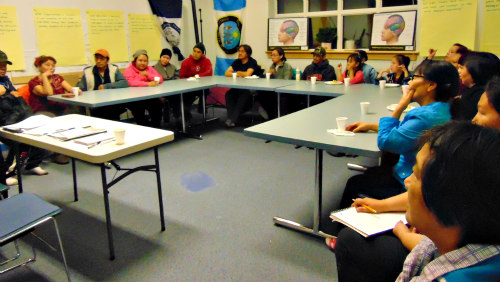Conducting Research with and on Inuit
While there are many ways to conduct and use the findings of research, for the purpose of CSWs, we will explore how different methods of conducting or using creative research methods both support Inuit traditional knowledge and experience, and supporting input into projects or strategies for social change.
Community-based Public Research (CBPR)
CBPR falls under category of research called "action research". The beginnings of action research have been credited to Kurt Lewin, a social scientist, who, in the 1940s, developed the method as a way to use research for making planned social change. Lewin used action research to blend the experimental approach used by social scientists with “programs of social action to address social problems.” Therefore, rather than observing community members or what was happening within communities or populations strictly from statistics and other points of data, through the behavioural and perceptions of people living in and through the issue for better understanding a vision of what has occurred to what can be.
Approaches to participatory methods of inquiry are multiple and are used in such diverse fields and settings as the social sciences, education, organizational science, nursing, and public health. Names for this method include terms such as:
- Action research
- Participatory research
- Participatory action research
- Community-based research
- Action science
- Action inquiry, and
- Cooperative inquiry.
Some authors use the terms action research and participatory action research synonymously.
Regardless, using CBPR methods is about engaging clients, families or communities on the basis of experiential and participative knowing, and allowing action research to explore that experience based on the individual's nature of their knowledge, justification, and the rationality of their beliefs about the issue or topic.

Definition of CBPR
Israel et al defined CBPR as focusing on social, structural, and physical environmental inequities through active involvement of community members, organizational representatives, and researchers in all aspects of the research process. Partners contribute their expertise to enhance understanding of a given phenomenon and integrate the knowledge gained with action to benefit the community involved. (Israel BA, Schulz AJ, Parker EA, Becker AB. Community-based participatory research: policy recommendations for promoting a partnership approach in health research. Educ Health. 2001)
Characteristics of the CBPR approach include:
- Recognizing the community as a unit of identity
- Building on the strengths and resources of the community
- Promoting colearning among research partners
- Achieving a balance between research and action that mutually benefits both science and the community
- Emphasizing the relevance of community-defined problems
- Employing a cyclical and iterative process to develop and maintain community/research partnerships
- Disseminating knowledge gained from the CBPR project to and by all involved partners, and
- Requiring long-term commitment on the part of all partners.
The strengths or advantages of CBPR are that it allows for the innovative adaptation of existing resources (government funding or use of assets). The approach allows researchers, CSWs and clients to explore local knowledge and perceptions about an issue, and empowers clients and their families by considering them agents who can investigate their own situations. CBPR when used in CDD engagement fosters the community input through creative methods and makes the project credible. When used in projects, it enhancing its usefulness by aligning it with what the community perceives as social and health goals.
Where there are clients or community members that are not homogenous (are not affiliated along a common identify, age, affiliation, etc.) CBPR has an ability to link participants who have varied skills, knowledge, and expertise to address complex problems in complex situations.
Conducting research, particularly CBPR action research often requires the use of supplies or other materials to enable engagement. This provides resources for the involved communities.
As well, through the collaborative nature of action research, projects provide a forum that can bridge across cultural differences among the participants, and helps dismantle the lack of trust communities may exhibit in relation to research.

Copyright © All Rights Reserved

